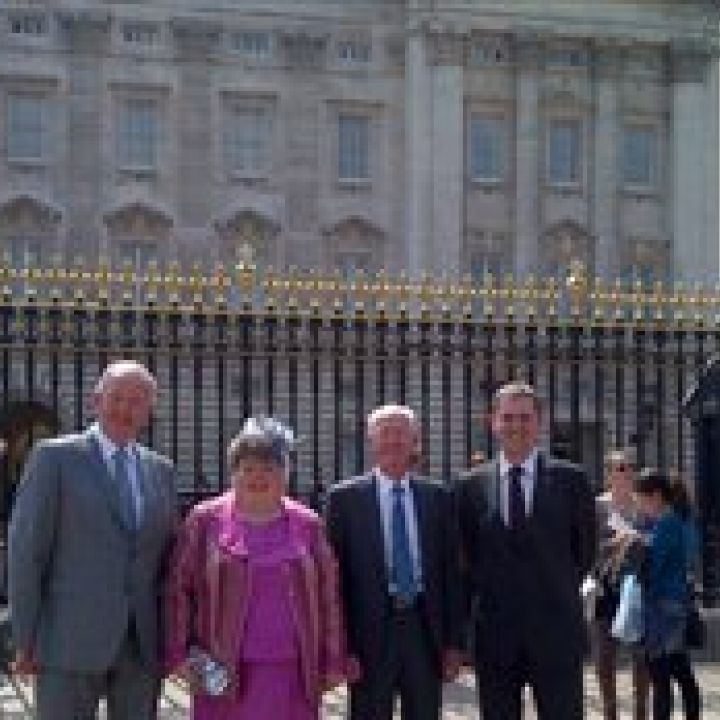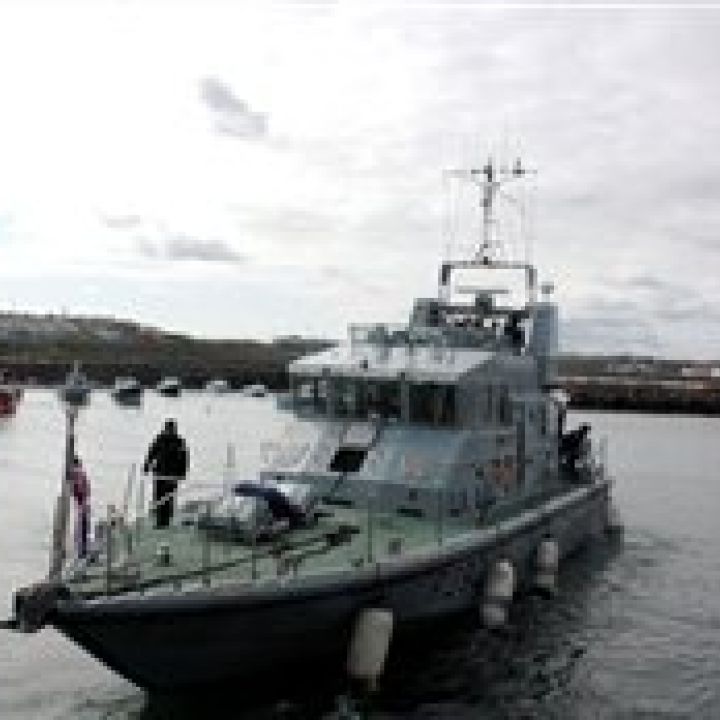Tendered to the Liverpool University Royal Naval Unit (URNU) since 1990, HMS CHARGER is based at Brunswick Dock on the site of the new Royal Naval Headquarters, Merseyside. The sixth ship to be named HMS CHARGER, she was built originally by Watercraft Limited, Shoreham, but completed and fitted out Vosper Thornycroft, being commissioned in June 1988. She has a displacement of 49 tonnes, a length of 68ft and a beam of 19ft.
Visiting Portrush from the 3rd. to the 6th. May 2012, the Commanding Officer took sea cadets and adult volunteers from Portrush to Londonderry on Saturday 5th; returning with a new cadet crew on Sunday 6th - the cadets received practical instruction on seamanship, navigation management and leadership, each cadet was allowed to 'drive' the ship.
Saturday was a memorable day - the arrival of the Unit' new seventeen-seat minibus, fully liveried in Sea Cadets refresh branding, very apt for the weekend for the cadets - LIVE THE ADVENTURE . . . . . . Not many young people, between the ages of 12 to 18 can say they have experienced life in a real Royal Navy ship. If you would like to Live The Adventure, come and join, Portrush Sea Cadets - telephone 028 708 25 999



Organised by the Royal Naval Association, the cadets and adult volunteers of Portrush Sea Cadets attended the Service of Commemoration on Sunday 6th May, the Battle of the Atlantic was the longest continuous military campaign in World War II lasting from 1939 to the defeat of Germany in 1945. It was at its height from mid-1940 through to the end of 1943. The Battle of the Atlantic pitted U-boats and other warships of the Kriegsmarine (German Navy) and aircraft of the Luftwaffe (German Air Force) against Allied merchant shipping. The convoys, coming mainly from North America and mainly going to the United Kingdom and the Soviet Union, were protected for the most part by the British and Canadian navies and air forces. These forces were aided by ships and aircraft of the United States from the 13th. September 1941.
From late 1940 to early 1942 HMS Venomous was part of the First Escort Group at Londonderry, Northern Ireland, which with the ships of the Royal Canadian Navy escorted the convoys across the Atlantic during the longest battle of the Second World War.
Some crew members came from Northern Ireland and others met their future wives there. And some like Jack Bolton did both. Jack did not fancy being a foot slogging soldier so travelled the seventy miles from his home to Belfast for a medical and joined the Royal Navy. After basic training at HMS Arthur in Skegness and a course as a torpedo-man at Devonport he was drafted to HMS Venomous at Londonderry in June 1942. The girl he was courting and later married was working in a shirt factory across the road from the naval base.
HMS VENOMOUS was a Short Range Escort (SRE) and left the convoys south of Iceland to dash into Havelfjord to refuel and usually remained there to escort the next incoming convoy but occasionally, as recalled by its RDF operator, "Freddo" Thomas and by Lt John Tucker RNR, rejoined the outgoing convoy and continued to Halifax, Nova Scotia.
The Canadian launch of A Hard Fought Ship took place at the Museum of the Atlantic in Halifax on the 18 June 2011. The author, Captain John A. Rodgaard USN (Ret),spoke about HMS Venomous and signed copies of his book. Moored alongside the Museum on the waterfront at Halifax is HMCS Sackville the last survivor of the 120 Canadian built corvettes which escorted the convoys to Londonderry.
Londonderry is particularly significant to sailors during the Battle of the Atlantic for providing much needed rest and relaxation to Allied sailors following convoy duty. During the course of the war at sea approximately 20,000 Royal Canadian Navy sailors made Derry their home-away-from-home, more than any other British port.

That special link remains today and on the 5 - 8 May 2011, Canadian naval veterans of the Second World War and their families, members of the Crow’s Nest (the wartime naval officers club in St Johns, Newfoundland); HMCS Sackville (the last surviving Canadian built wartime frigate) and the Nova Scotia Naval Officers Association (NSNOA) in Halifax and the Canadian and Edmonton Branch of the NOAC along with Captain (N) Harry Harsch, the Naval Attaché at the Canadian High Commission in London travelled to Londonderry to participate in ceremonies commemorating the Battle of the Atlantic and the loss of HMS Laurentic in 1917.
So successful was the pilgrimage that discussions are underway to plan a similar event in Halifax next year which would include St. John’s Newfoundland in the ceremonies. The Pilgrimage is tentatively called “On Triangle Run” to embrace the three communities linked by the longest battle of the Second World War.
The City of Derry has been named the Cultural Capital of the United Kingdom for 2013 , it is also the 70th anniversary of the turning of the tide against the U-Boats in 1943 during the Battle of the Atlantic, the Londonderry Branch of the Royal Naval Association (RNA) in conjunction with the Atlantic Chiefs and Petty Officer Association (ACPOA) has embarked on a project to install on the site of the stone frigate HMS Ferret (renamed HMS Sea Eagle after the war) a replica of the ACPOA’s Sailors’ Monument on the Halifax waterfront (right). Fundraising is underway and the RNA is hopeful that the monument – a tribute to the thousands of sailors from the Royal Navy, Royal Canadian Navy, US Navy, Free French, Free Dutch and Royal Indian Marine that called Londonderry home during the Second World War – will be in place for the 70th anniversary in 2013.

















